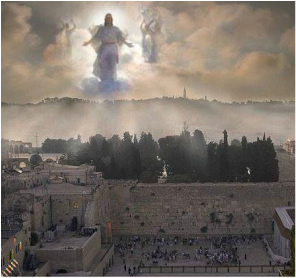Right before Jesus was arrested, he issued a bold prediction from the same location the “Egyptian” rallied his prophetic movement: the Mount of Olives (Matthew 24:3). He told his disciples, as they admired the grandeur of the Temple, that trouble was coming. They would suffer great persecution because of their allegiance to him. Armies would invade Jerusalem. The magnificent Temple would crumble (Matthew 24:2; Luke 21:20-24). And in the midst of chaos as people fled for their lives in Judea, prophetic hopes would be fulfilled.
First-century Israel had a line of would-be Messiahs making predictions. The Jewish historian Josephus recalls how “Impostors and demagogues, under the guise of divine inspiration, provoked revolutionary actions and drove the masses to act like madmen. They led them out into the wilderness so that God would show them signs of imminent liberation” (Jewish Wars 2.259). Their plans didn’t always work so well.
Theudas the magician called himself “a prophet” and led a group of followers to the Jordan River. He promised to divide the river as a sign of Israel’s restoration to greatness (based on Isaiah 51:10-11). It didn’t go as planned. He only succeeded in getting his head cut off by the Romans (Josephus, Antiquities 20.97-98).
A man nicknamed “the Egyptian” led a Jewish mob up the Mount of Olives with a promise to fulfill Zechariah 14. But instead of an earthquake splitting the city and God’s army defeating foreign invaders, the Romans cut the mob down.
Roman swords often cut short the hopes of long-awaited redemption. Theudas couldn’t kickstart Isaiah’s prophecy nor could “the Egyptian” fulfill Zechariah’s vision.
Why does it matter? Because Jesus spoke into that world. His predictions of coming redemption were equally rooted in Jewish prophecy and tied to contemporary political affairs. We must listen to him in that context.
“They will see 'the Son of Man coming on the clouds of heaven' with power and great glory.” - Matthew 24:30

The latest rage is tracking blood moons to see what will happen when the 4th one in 2 years appears in September 2015. Could it be the sign in heaven (Matthew 24:29) that precedes the Son of Man’s coming to earth?
Discussing when the Son of Man is coming jumps the gun. We cannot discuss when the “coming” will be until we understand where and what the “coming” is. Too many debates about the Bible assume what the language means and then try to answer misguided questions. One fundamental assumption about Matthew 24:30 is: the Son of Man is coming down from heaven to earth. But is that the direction of the “coming” Jesus predicted?
To understand what “coming” Jesus is predicting, we need to explore the Old Testament prophecy behind Jesus’ statement. The “Egyptian” tried to fulfill Zechariah 14, and Theudas started to enact Isaiah 51. When Jesus stood on the Mount of Olives, he predicted the culmination of Daniel 7:13-14.
Matthew 24:30 is a direct quote of Daniel 7:13. Daniel 7 is a vision of four beasts representing four human empires. Although the beasts and their horns depict historical kings and conquests in the beginning of Daniel 7, the "coming" takes place in a different visionary scene. In Daniel 7:9, the vision switches from beasts coming out of the sea to God's throne room. Prophetic visions of God's throne take us into the heavenly realm (see Ezekiel 1:1; Revelation 4:2). So Daniel 7:13-14 gives us a look at what is transpiring in heaven after tumultuous earthly events.
“And behold, with the clouds of heaven one like a son of man was coming. He came up to the Ancient of Days and was presented before His majesty. To Him was given dominion, glory, and a kingdom, so that people from every tribe, nation and language might serve Him.”
The vision in Daniel 7:13-14 is a divine coronation ceremony. A new ruler is beginning his reign of an all-encompassing kingdom. Daniel sees a human-like figure who represents "the saints" (Daniel 7:18-27) taking control of a new kingdom. That is the storyline Jesus invokes with his prediction of “the son of man coming on the clouds.”

Many interpreters of Scripture have misread the direction of the Son of Man’s coming. Our assumption about Jesus’ “return to earth” has stifled the basic Bible study practice of interpreting the New Testament in light of the Old.
The description of tumultuous events on earth in Matthew 24 should not lead us to conclude the Son of Man’s coming also takes place on earth. Daniel 7 blends the succession of earthly empires with visions of heavenly events. After four empires fall, then one like a son of man will “come up” to the Ancient of Days to receive his throne.
Jesus follows the paradigm of Daniel 7:13-14. He predicts the son of man coming up to God's throne in heaven.
The tumultuous events in Matthew 24 of disciples’ suffering, Jerusalem invaded, and the temple crumbling come to a climax in heaven. The son of man is not coming down to earth but rather up to God’s throne. The climax is the son of man becoming king over a new kingdom. The earthly events are the historical counterpart to a heavenly coronation.
Understanding the direction of the son of man’s coming may open up more questions than it answers. But what it does is give you accurate data.
Before we can interpret the whole of Matthew 24, we need to understand the parts. We cannot hope to understand the Bible if we have the wrong data to interpret. A single blog cannot answer all the questions you have about Jesus' prophecy in Matthew 24 (and Mark 13 and Luke 21), but it can correct our understanding of this one data point. I hope it gives you better data to use to interpret the whole.







 RSS Feed
RSS Feed
